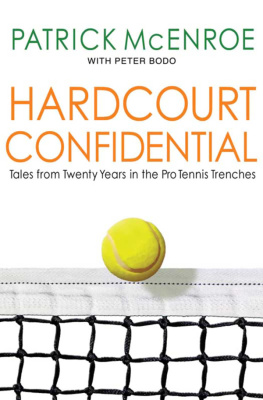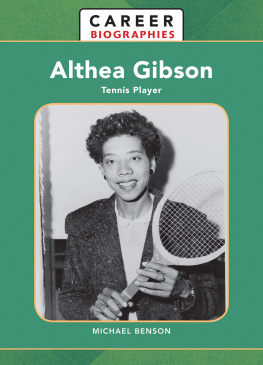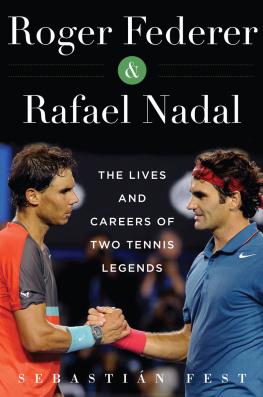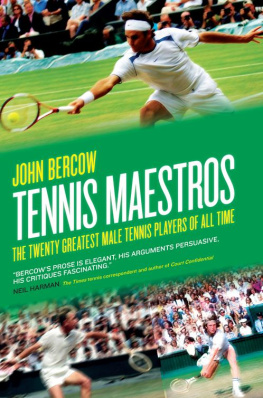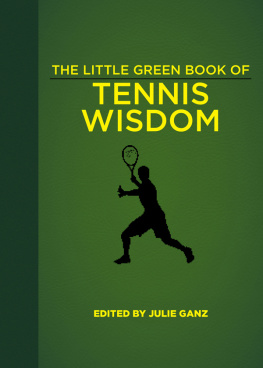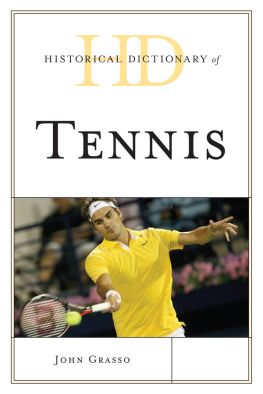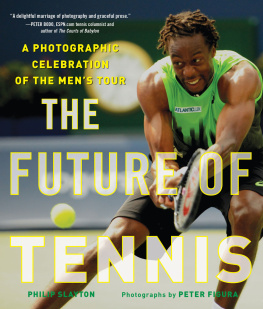
F OR M ELISSA,
WHO SURROUNDED MY OWN SMALL WORLD
WITH SO MANY NEW AND SHINING ONES, AND GIFTED
ME WITH OUR THREE BEAUTIFUL DAUGHTERS .
T he best reason to write a book is because you have a story to tell. In my case, Ill change that to the plural, stories . As a player, ESPN broadcaster, U.S. Davis Cup team captain, and head of player development for the United States Tennis Association, Ive experienced, observed, and been an integral part of many events and incidents that helped transform tennis into the electric, global game it is today. Only soccer has expanded its franchise to transfix more of the world than tennis, but give us a little more timeAfter all, the Open game is just over forty years old.
In fact, the very process by which tennis went global played out in my time, and is a story unto itself. Its easy for someone like me, or even a fan who follows the game on a daily basis, to get lost in the funhouse, forgetting the details of how we got where we are today. Where we are today is a place where the traditional stranglehold the United States, Australia, and a few other select nations had on tennis is broken. Where stylistic variety has yielded to a kind of world game. Where surfaces have been altered, sometimes drastically, to help create a more interesting, athletic game. Where fitness and biomechanics have caught up with technique as critical factors in success.
Where we are today is also a place where international stars are more well-known and visible to the public than ever before, which makes their storiesor stories about themthat much more compelling. Still, I wasnt convinced I needed or wanted to write a book until someone pointed out that I ought to take all those stories Ive told over a casual drink or dinnerstories that were often greeted with surprise, delight, shock, and even disbeliefand pull them together in one place. Thats how the idea for this book was spawned.
Ive been in the game for twenty-five years now, and Ive traded forehands, talked strategy, and rubbed shoulders off the court with loads of players. I have a wealth of experiences at big events, and have witnessed historic matches as well as important changes driven by game-shaping issues and people. Twenty-five is a nice, resonant number. Its also a big enough number to have made me feel a little urgency to tell my stories while they are still fresh and relevantwhile the people in them are still familiar. So I figured, what the hellserve em up.
The most challenging part of collecting all these stories in one place was finding the right way to tell themits easier for someone who sets out to write a straight autobiography. My collaborator, Peter Bodo, and I decided to adopt a loose, calendar-based format of twelve chapters, corresponding to the events of the year, because tennis is, after all, an all-year sport. Each chapter handles themes appropriate to the month, or personalities who are linked to the events that take place that month.
We didnt want to force the issue, though. We just wanted to impose some direction on our kaleidoscopic journey through twenty-five years of tennis, covering all aspects of my experiencefrom growing up a McEnroe to trying to alter our nations official approach to creating champions; from hitting with Roger Federer to navigating the conflicts inherent in having multiple roles in the game; from certain high (or low) moments of my career, to the transformation of the very way the game is played.
It would have been incomplete to tell my stories without trying to connect some dots and extract some meaning from the material. So Ive been free in expressing my opinions and convictions. Thats going to surprise some people, because I was always known as the mild McEnroein fact, when we were kids, my brothers teasingly called me Perfect Pat. I was far from perfect then, and Im far from perfect now, but I still felt an obligation to produce a book thats honest, colorful, and tackles issues head-on.
I hope that when you finish the last page and close this book, youll feel like you know and understand more about the players, events, and trends that have shaped the past quarter-century in tennis. I hope its as stimulating and entertaining a ride for you as it has been, and I hope continues to be, for me.
Patrick McEnroe
New York, February 9, 2010
THE AUSTRALIAN SEMIS: BECKER, EDBERG, LENDL, AND P. M C ENROE
T he first round of the Australian Open, 1991: There I was, on a field court way out in the middle of nowhere, playing Swedens Tomas Hogstedt. I was lucky to be there at all, despite the terrible beating Hogstedt was inflicting on me. With a ranking of no. 120, I was the last player accepted into the main draw. If I were ranked one measly spot lower, I wouldnt even have bothered to make the trip just to play qualifying.
Hogstedt had me by two sets, and I was serving, down a break already in the third, at love30. With two swings of the racket, Tomas could deliver the equivalent of a knockout blow. As I hit my next serve, my baseball cap slipped on my head, covered my eyes, and I lost the pointand I felt utterly like a doofus. Fucking hat , I thought, ripping it off my head and casting it aside. Fuck this hat!
Here it was, triple break point for Hogstedt.
Somehow, though, I ended up holding the game and suddenly things started looking better. Tomas seemed to be tiring. And once I clawed my way back into that third set, I got a huge boost of energy and confidence. I took the set, and won the next two with authority.
After I beat Hogstedt, the draw opened up for me; that happens sometimes: a big upset here, a withdrawal there, and a guy with a bit of luck can go very deep in an event without having to play a legitimate contender or proven champion. As an unseeded player, I might have met a top seeda Boris Becker or Ivan Lendlin the first or second round. Instead, I got Hogstedt, followed by a low-ranked player who was in on a wild card and had won his first match.
After that, I had a tough match with one of the games best competitorsand currently one of my top aides in USTA player developmentJay Berger. I won that one in straights. Then, I had a good win over the Aussie hope Mark Woodforde to make the quarters, where I met no. 101 Christiano Caratti. No offense to Caratti, but most guys would give their eye teeth to get a player of his caliber (or me, for that matter) in the quarters of a major.
I quickly went up two sets to love on Caratti, but then I hurt my back. I received treatment a few times in the fourth and fifth, but I was determined to tough it out. I rallied from losing the third and fourth sets to win in five, and earn a date with Boris Becker with a place in the final on the line.
An experienced tennis fan reviewing the facts could easily put my run down to the luck of the draw. I didnt entirely see it that way, because I knew how hard I had worked and how much I craved validation. At the time, I was already a very good doubles player, with a Grand Slam tour championship title to my name. Because of my quick success in doubles and maybe a little bit because of my family tree, I had assumed I was going to make it in singles. I thought I was good enough.
But I realized after about a year and a half of trying: Im not gonna make it. Not unless I did something differently. So in 1991, I trained for the upcoming Australian Open like never before, although the process actually began a full year earlier, at the end of 1989, back at our family compound in the Long Island, New York, town of Cove Neck.
I stayed out at the house for a month, and I ran every morning for ninety minutes, trained on court for a few hours, then went running again for another ninety minutes in the afternoon. (Incidentally, I wouldnt dream of recommending that amount of jogging for any aspiring player.) I didnt know what I was doing, but I was doing it hard, and I did know one thing: I needed to lose weight. I had to shed some of those pounds Id gained at Stanford, where eating an entire pizza and drinking a few bottles of Coke were a standard pre-bedtime snack. I ran fifteen miles a day, in addition to working on the court for three, four hours a day.

